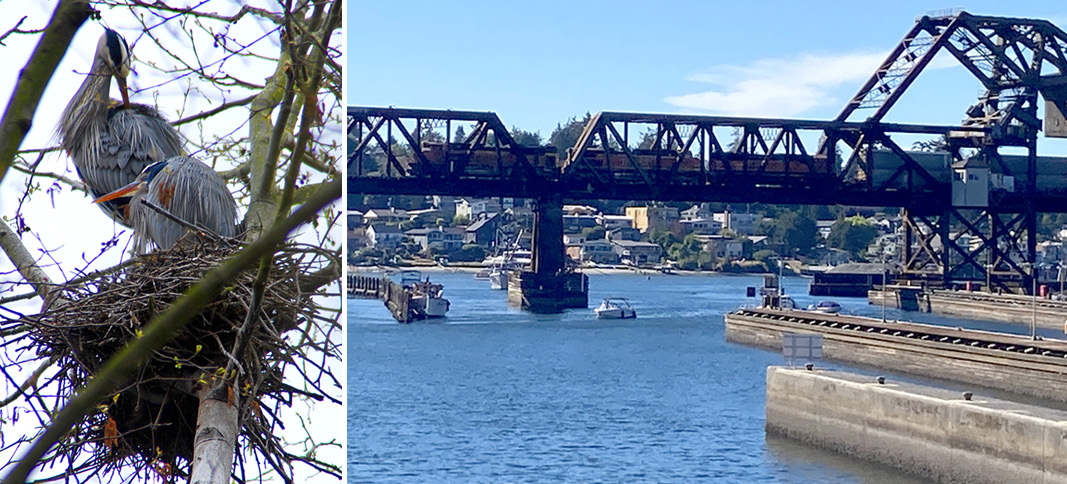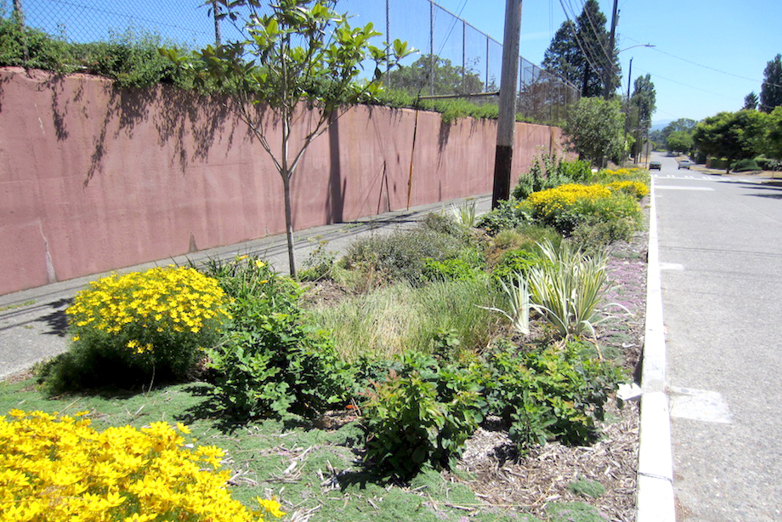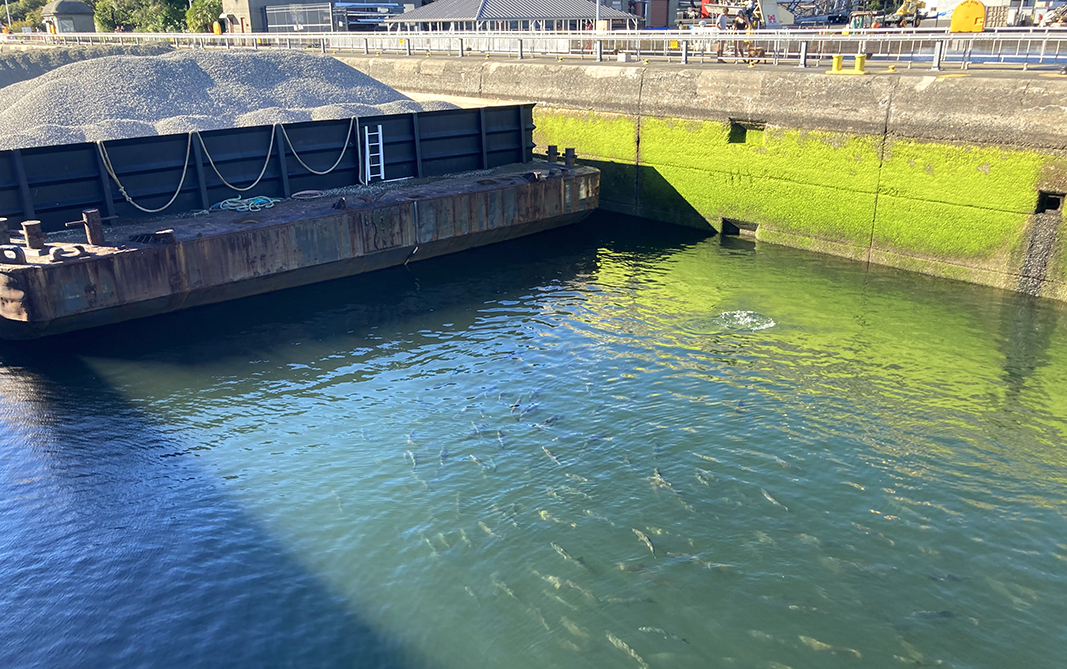Top: Author Sally Brown’s neighborhood. ©Google Maps
 Sally Brown
Sally Brown
I am very fortunate to live in a part of Seattle where natural systems and urban systems co-exist. I live right next to the Ballard Locks — the place where boats from the freshwater lakes pass into the Puget Sound. In the other direction, this is also where the salmon head from the ocean to the rivers and streams to spawn. The locks were designed with a fish ladder to help the salmon on their journey.
This concentrated migration corridor has also drawn the attention of the seals and sea lions who view it as more of an all you can eat opportunity. To mitigate this and help out the salmon, the managers of the locks have installed a sound system to make loud noises to scare off the seals. A heron rookery is a few steps past the entrance to the locks. In the spring you can see up to 60 herons in their nests. This part of the park isn’t mowed for months to give the birds a quieter place to raise their young. Just past the locks is the railroad bridge where freight and passenger trains make their way up the coast. Every day when I walk the dog I marvel at this coexistence of people and nature. It can be done.

A heron rookery, a railroad trestle (above right), and the entrance to the Ballard Locks (lower right) are all within a stone’s throw of each other. Photos by Sally Brown.
The larger picture of coexistence, however, gets obscured by day-to-day realities. If you read any of the recent series on PFAS in compost and biosolids, you are well aware of the focus on parts per billion. But focusing on the parts per billion aspects of human impact — trying to keep soils and waters free of this 0.000 000 001 level of human impact — distracts us from the fact that there are 8,000,000,000 of us stepping all over the surface of the planet. PFAS are not good compounds and we should get them out of the vast number of products that contain them. I’m not disagreeing there. But perhaps more focus should be directed towards how to lessen the impact of the 8 billion of us. About half of this 8 billion live in or around cities and that percentage is expected to grow.
In addition to being where people live, cities are the economic engines that drive our economy (Koop and van Leeuwen, 2017). Cities are also the source of up to 75% of global carbon dioxide (CO2) emissions. Not taking care of urban infrastructure will wreak havoc on populations and the economy. Internationally many cities don’t have functional water or wastewater systems.
Many cities don’t have ways to appropriately deal with waste. Climate change stresses supplies and systems. This is made worse in cases where systems are crumbling or don’t exist. Rebuilding, or building now with a resilience mindset can both make us ready for disaster and potentially even prevent it. It also makes for nicer places to live for the majority of the world’s population.
Understanding how to make cities work with natural systems rather than paving them over is a current and critical focus of urban planning and research. This takes two forms: How to reduce the footprint of the city and how to incorporate natural elements into the function of the city.
Reducing The Footprint
All the people that live in these cities use stuff. In that process we also make what has for decades been considered to be waste. Understanding the value of that “waste,” something those in our industry have done for decades, is now the focus of entire journals. There are new terms like “circular economy,” “urban metabolism” and “urban harvest” in widespread use. In a circular economy there is an attempt to replace lines with circles. For example, instead of taking all of the water we’ve used already and discharging it into a river or ocean, the thought is that we can clean that same water and just use it again. Why get new when you can use or repurpose old?
Urban harvest and urban metabolism (a model to facilitate the description and analysis of the flows of the materials and energy within cities) take the circular economy and apply it to cities. Papers have looked at how much waste heat, waste water, waste carbon and waste nutrients there are in cities that can be recovered and repurposed. One study estimated that urban harvesting could provide all of the energy, 55% of the heat demand and 52% of the tap water demand for the Netherlands (Agudelo-Vera et al., 2012). Another study calculated that the nutrients and carbon in peoples’ wastes would be enough to fertilize the rooftops and empty lots in Rotterdam and grow enough food to feed the city (Wielemaker et al., 2016). The caveat with that one is that the authors recommend a new type of wastewater treatment system. Current, centralized wastewater wastes the majority of the nitrogen entering the system. Here the authors are suggesting that it is well past time to make peeing in a cup standard operating practice. I admit that this is something we do regularly at home for the hungry houseplants. I also read in the New York Times that this very practice is gaining traction.
However, before we completely overhaul the wastewater treatment systems that we currently use and rely on, perhaps we should take advantage of the nitrogen that is already in the biosolids. Take the Netherlands for example, the source country for two of the papers I’ve cited. As of 2016, just about all of the biosolids generated there were incinerated — effectively burning up all of the nitrogen that they contained (Collivignarelli et al., 2019). Kudos to the communities that are already treating their biosolids as an integral component of the urban metabolism. Same for the food scraps and yard trimmings. This is integral to walking the walk of a circular economy. It is also walking the walk and with a much lighter step. This is not to say that our existing systems can’t be improved upon, which includes getting PFAS compounds out of the vast number of products that contain them. But recognizing that the value of recycled organics can be captured now is the way to start on the right path.

Biofiltration strip constructed in King County, Washington is an example of green infrastructure that uses compost in the engineered soil mix.
The second part of this strategy is incorporating nature into our cities. There are many ways that this can be done. I’ve written about green storm water infrastructure (More Green; Compost For Storm Water On The Roadside; Cleaning Powers Of Soil). Integrating natural systems into our engineered ones is a powerful example of this concept. So is urban agriculture. So is using compost in parks and gardens. Recent studies have shown that increasing green space (gardens, parks, back and front yards) in urban areas has a positive impact on public health (Kondo et al, 2018). Being surrounded by green reduces mortality, heart rate and violence. It increases physical activity and improves mood.
In short, if we can manage to switch the focus from parts per billion to the billions of us that live here, we can tread much more gently on this earth. Embracing the circular economy as it applies to the wastes that are, in truth, treasures is critical. Making it so urban areas embrace natural systems is a logical extension of that concept. If you aren’t ready to pee on your roses, that is okay. Just make sure to put some compost on your garden.
Sally Brown, BioCycle Senior Adviser, is a Research Professor at the University of Washington in the College of the Environment.














